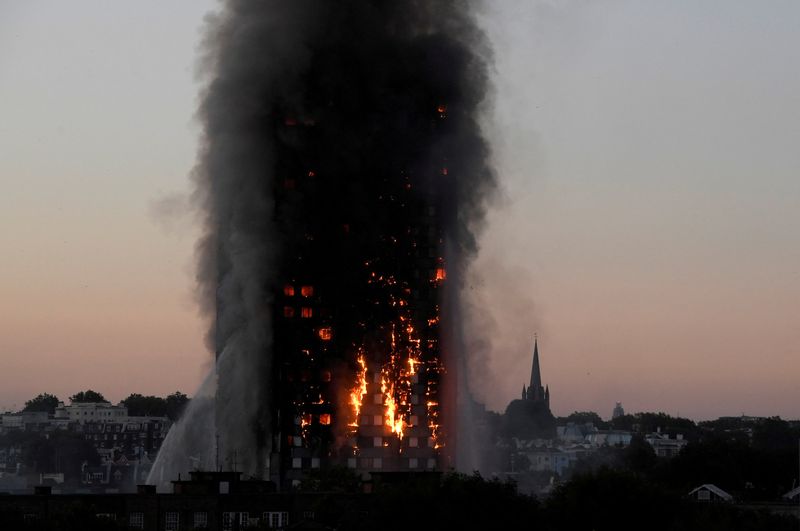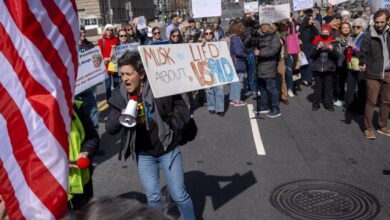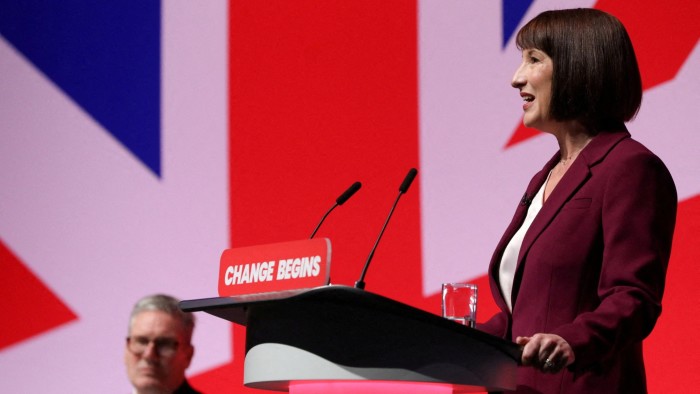No penalties for UK firms that used deadly building material By Reuters

Written by Tom Bergin
LONDON (Reuters) – When the deadly Grenfell Tower fire in 2017 revealed that high-rise public housing buildings across Britain were enveloped in flammable cladding, the government vowed that responsible building contractors would pay for their negligence.
Seven years later, contractors who installed cladding panels that did not meet fire safety standards when installed have largely escaped financial liability, according to a Reuters review of more than 100 buildings.
Cladding is a layer of insulating material applied to the walls of a new or existing building to improve its thermal performance. The Grenfell Tower fire, which killed 72 people, raised public awareness that thousands of buildings in the UK were covered in flammable materials.
To quickly address the problem, the British government allocated a lot of money to allow the replacement of flammable cladding in subsidized public housing. Then, in order to recoup taxpayer money, the Housing Ministry said it would work with building owners to encourage legal claims against contractors who installed defective facades.
Under UK law, the owner of a property that has been renovated in a way that does not meet the building regulations in force at the time can sue the contractors and designers responsible, and in some cases the manufacturer of the materials used, for remedial costs.
The Reuters review identified 103 public housing buildings owned by 26 local councils and non-profit housing associations that had cladding of a type deemed non-compliant by the government, the courts or the public inquiry into the Grenfell fire.
Only five of the 26 owners – responsible for 25 of the 103 buildings – said they had sought some compensation from the companies that installed the flammable cladding. Three of them succeeded in recovering some of the money while two are still in mediation with contractors in cases that did not reach court. Reuters found that the total money recovered represents only 13% of the cost of restoring the 103 buildings, which exceeded 260 million pounds ($325 million).
Four lawyers who represented building owners and contractors in cladding cases after the Grenfell incident told Reuters that trust rules set up by the government to disburse money for repairs had inadvertently created disincentives to prosecute errant builders. If public housing bodies win lawsuits against contractors, the proceeds must be handed over to the government, under the rules, while the legal costs of a losing battle must be borne alone.
The National Housing Federation, which represents social housing bodies across Britain, said the government could have increased the number of claims by covering litigation costs and providing legal guidance.
Reuters found no evidence of a deliberate plan by the government to discourage compensation claims.
However, the Ministry of Housing, Communities and Local Government said its national re-cladding scheme prioritized the rapid removal of dangerous cladding over cost recovery from contractors. It declined to comment on criticism that its rules discourage lawsuits against officials or answer questions about the level of claims against construction companies. It has also not commented on whether it will amend the rules for its cladding schemes to facilitate more claims to help recover taxpayer money.
The Reuters analysis is the first large-scale review of the extent to which contractors have contributed to the re-cladding of public housing buildings to which they have attached non-compliant cladding, and reveals the small number of cases that have been brought against contractors.
Giles Grover, co-leader of the End Our Cladding Scandal campaign, which includes groups representing renters affected by the national crisis, said the low number of compensation claims identified by Reuters was disappointing.
He added: “It is frustrating that contractors have not paid the costs of repairing these blocks, despite all the promises made by the government that it will make them pay.”
A nationwide scandal
The Grenfell disaster in Kensington killed dozens of residents when the building’s plastic-filled exterior panels turned a small fire in one of the flats into an inferno that consumed the 24-storey high-rise in west London.
The government said in 2017 that the panels used did not comply with applicable regulations when installed. The official investigation, which published its final report in September, agreed and noted that none of the companies responsible even claimed the cladding met regulatory requirements.
After the fire, inspections by local councils and housing associations, which provide supported housing to low-income families, found that similar panels and other forms of cladding that did not meet fire regulations were being installed on buildings across the country.
The government’s spending watchdog said in November that more than 700 public housing buildings had had their cladding replaced in the wake of the Grenfell disaster, while about 1,800 others still needed to be insured. The total cost of treatment will exceed 4 billion pounds, according to government figures.
The watchdog noted that with public housing owners running out of cash, the government could be on the hook to foot the bill.
The alternative to using public funds to pay for remediation costs is for owners to sue the building contractors, designers or manufacturers responsible for the original cladding, said Chris Leadbetter, a lawyer at Clyde & Co., which has defended building contractors in dozens of courts. Cladding cases.
Reuters identified buildings in need of recladding using council data, media reports, social media posts and other sources. Reuters then determined whether the original cladding was compliant when installed using statutory financial accounts, satellite images, planning documents, freedom of information requests, minutes of local council meetings and discussions with dozens of lawyers, housing groups and local councils.
Susannah Nicol, chief executive of Build UK, which represents builders, said the industry was accepting of not installing non-compliant cladding, but said contractors did not have the financial strength to cover all the repair costs alone. Others, including designers and product manufacturers, are partly responsible and therefore must share the financial burden, she said.
“I don’t think any company would come forward and pay for something if they weren’t confident they were responsible,” she added.
The construction companies responsible for the non-compliant cladding identified by Reuters in 103 public housing buildings reviewed included British-based Wilmott Dixon and Allumet, listed on the Paris Stock Exchange. Puig (EPA:) SA and United Living, owned by US private equity group Apollo. Willmott Dixon, Bouygues and Apollo declined to comment on the cladding contracts while Alumet did not respond to queries.
‘Significant disincentive’ to sue
Most public housing providers declined to specify reasons for pursuing or not pursuing cases.
But the rules for cladding remediation funds created by the government in the wake of the Grenfell disaster provide an answer, according to the National Housing Federation and lawyers interviewed.
The government set up its first funds in 2018 to ensure cash-strapped public housing owners can make their buildings safe as quickly as possible. The government said it expects the beneficiaries of the funds to file reasonable cases against the contractors and repay the government for any compensation they receive.
The oldest fund, set up in 2018, has so far provided £300m of taxpayers’ money to councils and housing associations, official data shows. This fund has recovered less than £1 million as a result of compensation claims, according to a freedom of information request.
In one case, Sheffield Council decided not to prosecute London-listed firm Morgan Sindall, which the council said had installed non-compliant polyethylene core panels – such as those used in Grenfell – in its Hanover Tower building.
The council said in a 2020 report that there may be a “public interest” in proving the facts in court, but as the government had already covered the costs of resurfacing, spending money on what would likely be expensive was not in the interests of council taxpayers. . “Interests.
Eric Johnston, legal director at Edinburgh law firm Brodies, said the fact that the government did not fund litigation but wanted to collect the proceeds of any litigation created a “huge disincentive” for social housing providers to bring a lawsuit.
Morgan Sindall told Reuters he did not believe he had any responsibility in relation to the Hannover Tower, without elaborating. Sheffield declined to comment on the case.
Only three of the 26 building owners reviewed by Reuters said they had actually received compensation from contractors in relation to cladding claims. The first, Newport City Homes housing association in South Wales, began its claim before the government set up its first cladding fund. Newport City Homes requested the cost of making three buildings safe from building contractor Wits Group, which installed polyethylene baseboards as part of a 2013 refurbishment. Its accounts show the housing association received a £4m settlement from Wits without going to court.
Wits said it did not intentionally install incompatible products. It declined to answer questions about Newport or any of the 23 other high-rise buildings where Reuters found the company had installed polyethylene cladding panels.

John Cawthorn, a former firefighter who lived in Sheffield’s Hanover Tower for 33 years, told Reuters he was angry that builders who installed non-compliant cladding on blocks like his across the country were not being held to account. Cawthorne said the tenants were haunted by the fact that they could have easily died like the Grenfell victims.
“I live on the 15th floor of this building. I’m right at the top,” the 68-year-old said. “The same thing could have happened here. There’s no doubt about it. We could all have died.”
https://i-invdn-com.investing.com/news/world_news_3_69x52._800x533_L_1419494235.jpg
2025-01-06 06:16:00





